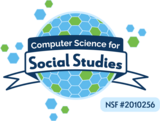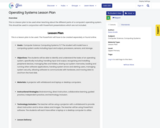
The student will identify and interpret data and organize it in order to make a prediction, with or without a computing device.
- Subject:
- Data and Analysis
- Material Type:
- Lesson
- Author:
- Wendy Johnson
- Date Added:
- 04/09/2024

The student will identify and interpret data and organize it in order to make a prediction, with or without a computing device.

Connect LAN, WAN, and WWW through the exploration of telephone lines.

This resource was created to help students grasp a better understanding of what and how an algorithm works.

Make life cycles and data recording “egg”-citing! Incubate eggs in your classroom. As you do, monitor and record data.

Students become authors as they use technology to create an ebook to share with their classmates. Students chose the life cycle of a flowering plant, frog, or butterfly. They review with hands-on resources and peer collaboration. They then use their ipad with the app “Book Creator” to create a book using real life pictures!

Today we do lots of activities online. Students need to know the importance of having a secure password to keep their information safe when using the internet. In this lesson students will learn to make a safe password with a hands on activity.

Students will use the Makey Makey board to create an interactive poster using weather images, recordings and/or text to display their knowledge of weather. They will use conductive materials to create conductive touchpoints.

Students will be able to distinguish between weak and strong passwords and how passwords could have looked in Ancient Egypt! Using the stamps, hieroglyphics stamps, magnetic letters, and papyrus paper, the students will be able to create passwords. Dive into the differences in Ancient Egypt and today and learn how to keep your information safe!

Students will be able to explore the different continents by making a model of a continent of their choice! Using the globe, modeling clay, placemats, and other tools, the students will be able to use their creativity to produce a model of a continent. Dive into the different continents and allow your students access to expand their knowledge using creativity!

In this lesson, students will use the iterative design process to construct a story map for a fictional short story.

Students will learn about Mask Letters and their use in the Revolutionary War, then they will make masks and messages of their own and discuss the pros and cons of this method of sending and receiving secret messages.

Students will be able to explore matter, by getting hands-on experience experimenting with salt, sugar, sand, color changing beads, and hot and cold water.! Using the materials, the students will be able to use various materials to practice how objects interact with water.. Dive into matters and allow your students access to expand their knowledge using information that is transmitted using computing devices, because the students will record themselves discussing their results from their experiment to share with their classmates.

Students can explore maps and electronic communication with this hands on map activity. Add an extension to make a classroom quilt map!

Students will sort and graph attributes of the Lakota, Powhatan, and Pueblo tribe. They will then rotate through groups and make models of items.

Students will be split into groups to create materials and items that belong to their assigned Native American tribe. While in groups they will collaborate with one another in each of them making an item that belongs to their assigned tribe. The teacher will be able to access the groups understand of their tribe based on their groups representation of their assigned tribe.

This lesson is for Networking and the Internet. The student will learn the difference between a network and the internet. They will be reminded of the importance of internet security and safety and how not everything on the internet is real. This lesson will use videos, books and hand on time to understand the how a network vs the internet works.

Technology has not just changed over time. It has changed the way citizens live their lives and perform their jobs. This lesson will discuss how communication has changed over time in the local community.

In this exciting and interactive experiment, students will have the opportunity to discover and understand the relationship between force and mass regarding the movement of various-sized balls. Through the use of Spheros, these ingenious devices will enable students to apply force to balls of different sizes, including the wiffle ball, racquetball, softball, and ping pong ball. By observing the fascinating dynamics at play, students will gain invaluable insights into how force and mass influence the trajectory, speed, and overall movement of these balls. This hands-on activity is sure to spark curiosity and foster a deeper appreciation for the principles of physics in a fun and engaging manner.

This is a lesson plan to be used when teaching about the different parts of a computer's operating system. This should be used in conjunction with PowerPoint presentations which are not included.

Students will use an unplugged computer science task of sorting networks to order numbers, least to greatest.